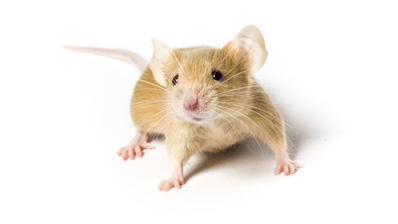Calcium and sodium are critically important minerals for a host of physiological processes in nearly every living thing. In humans, calcium is needed for, among other things, strong bones and teeth, and it is a key participant in cellular communication. Its deficiency is a risk factor for osteoporosis, high blood pressure, heart disease and some forms of cancer. Sodium is perhaps the most important ion in maintaining the body's electrical balance. Excess sodium intake is a risk factor for hypertension.
In spite of the importance of these two minerals, scientists understand little about the factors that make people crave, avoid or be indifferent to calcium- and sodium-rich foods.

A group of chemists at the Monell Chemical Senses Center, Philadelphia, took a new approach — a genetic approach — to this question. Led by Dr. Michael Tordoff, these chemists characterized the calcium and sodium preferences of male and female mice from the 40 core strains (nearly all JAX® Mice) in the Mouse Phenome Database (MPD), a repository of phenotypic information from inbred mouse strains (Tordoff et al. 2007a, 2007b). The characterization of calcium and sodium taste preferences in these strains lays the groundwork for scientists to perform QTL analyses and discover the underlying genes in mice and humans. Once the genetic mechanisms of calcium and sodium preference are understood, health professionals may be able to influence people's eating habits for the foods containing these minerals.
Calcium taste in mice
Approximately 70 percent of men and 90 percent of women in the United States don't consume enough calcium. Why? One reason may be that calcium and high-calcium foods taste bitter to many people. Seemingly, the same is true in mice. Dr. Tordoff and his colleagues found that calcium intake in the 40 Mouse Phenome Database strains depends on strain, sex, type of calcium anion and calcium concentration. In 11 strains, females prefer and consume more calcium than males do. Nine strains prefer calcium lactate (CaLa) over calcium chloride (CaCl2), but only one strain (JF1/Ms) prefers CaCl2. Some strains (e.g., PWK/PhJ, BTBR T+ tf/J, JF1/Ms) are calcium lovers, preferring calcium solutions over water. Others (e.g., KK/HlJ, C57BL/10J, CE/J, C58/J) consistently avoid calcium solutions. Calcium intake is not significantly correlated to any of the following variables: blood pH, blood ionized calcium concentration, plasma total calcium concentration, bone mineral density, and bone mineral content. However, calcium-loving strains generally have extreme phenotypes for these variables.
Calcium Taste Genes
By performing QTL analyses in several Mouse Phenome Database strains, Dr. Tordoff and his colleagues have identified two calcium taste genes, each encoding a mouse tongue receptor involved in tasting calcium. One receptor is a calcium-sensing receptor called CaSR and has been found by other researchers in the parathyroid glands, kidney, brain and gastrointestinal tract, but never on the tongue (American Chemical Society 2008). The other was unexpected — a receptor known as T1R3, a component of the sweet-taste receptor (Tordoff et al. 2008).
Sodium taste in mice
Unlike calcium, sodium generally tastes good to most people, so people generally over-consume rather than under-consume it. Dr. Tordoff found that, as with calcium intake, sodium intake in the 40 Mouse Phenome Database strains depends on strain, sex, type of sodium anion and sodium concentration. Nine strains prefer NaCl over sodium lactate (NaLa), and only one strain (I/LnJ) prefers NaLa. The other 30 strains show no preference between NaCl and NaLa. The females of eight strains love sodium more than the males do. Strains 129S1/SvImJ, MA/MyJ, NZW/LacJ, and SWR/J are sodium lovers, preferring sodium solutions to water; strains A/J, C57BL/6J, FVB/NJ, and SEA/GnJ show no preferences; and AKR/J, strains C3H/HeJ, C57BL/10J, CBA/J, DBA/2J, I/LnJ, JF1/Ms, LP/J, NON/ShiLtJ, PERA/EiJ, PL/J, and RIIIS/J ingest low levels of sodium.
To see details of Dr. Tordoff's work go to Mouse Phenome Database.
References
American Chemical Society. 2008. That tastes sweet? Sour? No, it's definitely calcium! American Chemical Society (press release, 8/20/08).
Tordoff MG, Shao H, Alarcon LK, Margoldkee RF, Mosinger B, Bachmanov AA, Reed DR, McCaughey S. 2008. Involvement of T1R3 in calcium-magnesium taste. Physiol Genomics 34:338-48.
Tordoff MG, Bachmanov AA, Reed DR. 2007a. Forty mouse strain survey of voluntary calcium intake, blood calcium, and bone mineral content. Physiol Behav 91:632-43.
Tordoff MG, Reed DR, Bachmanov AA. 2007b. Forty mouse strain survey of water and sodium intake. Physiol Behav 91:619-30.